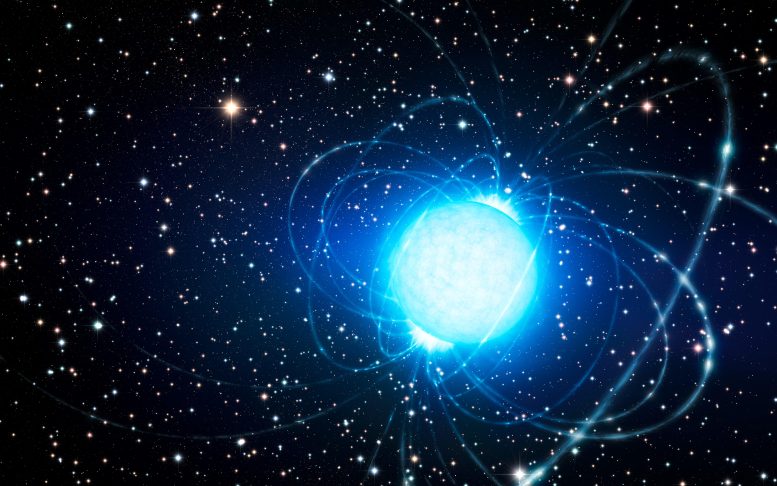
This artist’s impression shows a magnetar in the star cluster Westerlund 1. Credit: ESO/L. Calçada
According to a new study the X-ray light emitted by a certain magnetar – a highly magnetized dead star – appears to indicate that the star has a solid surface and no atmosphere.
A study published in the journal Science has used data from NASA’s Imaging X-ray Polarimetry Explorer (IXPE) satellite to reveal that a highly magnetized dead star known as a magnetar has a solid surface with no atmosphere. Led by researchers at the University of Padova, the study represents the first time polarized X-ray light from a magnetar has been observed. This was the first time polarized X-ray light from a magnetar had been observed.
IXPE, a collaboration between NASA and the Italian Space Agency, allows scientists to examine X-ray light in space by measuring its polarization – the direction of the light waves’ oscillation. The team studied magnetar 4U 0142+61, located in the Cassiopeia constellation approximately 13,000 light years from Earth.
Magnetars are neutron stars – very dense remnant cores of massive stars that have exploded as supernovae at the ends of their lives. Unlike other neutron stars, they have an immense magnetic field – the most powerful in the universe. They emit bright X-rays and show erratic periods of activity, with the emission of bursts and flares which can release in just one second an amount of energy millions of times greater than our Sun emits in one year. They are believed to be powered by their ultra-powerful magnetic fields, 100 to 1,000 times stronger than standard neutron stars.
The research team found a much lower proportion of polarized light than would be expected if the X-rays passed through an atmosphere. (Polarized light is light where the wiggle is all in the same direction – that is, the electric fields vibrate only in one way. An atmosphere acts as a filter, selecting only one polarization state of the light.)
The team also found that for particles of light at higher energies, the angle of polarization – the wiggle – flipped by exactly 90 degrees compared to light at lower energies, following what theoretical models would predict if the star had a solid crust surrounded by an external magnetosphere filled with electric currents.
Co-lead author Professor Silvia Zane (UCL Mullard Space Science Laboratory), a member of the IXPE science team, said: “This was completely unexpected. I was convinced there would be an atmosphere. The star’s gas has reached a tipping point and become solid in a similar way that water might turn to ice. This is a result of the star’s incredibly strong magnetic field.
“But, like with water, temperature is also a factor – a hotter gas will require a stronger magnetic field to become solid.
“A next step is to observe hotter neutron stars with a similar magnetic field, to investigate how the interplay between temperature and magnetic field affects the properties of the star’s surface.”
Lead author Dr. Roberto Taverna, from the University of Padova, said: “The most exciting feature we could observe is the change in polarization direction with energy, with the polarization angle swinging by exactly 90 degrees.
“This is in agreement with what theoretical models predict and confirms that magnetars are indeed endowed with ultra-strong magnetic fields.”
Quantum theory predicts that light propagating in a strongly magnetized environment is polarized in two directions, parallel and perpendicular to the magnetic field. The amount and direction of the observed polarization bear the imprint of the magnetic field structure and of the physical state of matter in the vicinity of the neutron star, providing information inaccessible otherwise.
At high energies, photons (particles of light) polarized perpendicularly to the magnetic field are expected to dominate, resulting in the observed 90-degree polarization swing.
Professor Roberto Turolla, from the University of Padova, who is also an honorary professor at the UCL Mullard Space Science Laboratory, said: “The polarization at low energies is telling us that the magnetic field is likely so strong to turn the atmosphere around the star into a solid or a liquid, a phenomenon known as magnetic condensation.”
The solid crust of the star is thought to be composed of a lattice of ions, held together by the magnetic field. The atoms would not be spherical but elongated in the direction of the magnetic field.
It is still a subject of debate whether or not magnetars and other neutron stars have atmospheres. However, the new paper is the first observation of a neutron star where a solid crust is a reliable explanation.
Professor Jeremy Heyl of the University of British Columbia (UBC) added: “It is also worth noting that including quantum electrodynamics effects, as we did in our theoretical modeling, gives results compatible with the IXPE observation. Nevertheless, we are also investigating alternative models to explain the IXPE data, for which proper numerical simulations are still lacking.”
Reference: “Polarized x-rays from a magnetar” by Roberto Taverna, Roberto Turolla, Fabio Muleri, Jeremy Heyl, Silvia Zane, Luca Baldini, Denis González-Caniulef, Matteo Bachetti, John Rankin, Ilaria Caiazzo, Niccolò Di Lalla, Victor Doroshenko, Manel Errando, Ephraim Gau, Demet Kırmızıbayrak, Henric Krawczynski, Michela Negro, Mason Ng, Nicola Omodei, Andrea Possenti, Toru Tamagawa, Keisuke Uchiyama, Martin C. Weisskopf, Ivan Agudo, Lucio A. Antonelli, Wayne H. Baumgartner, Ronaldo Bellazzini, Stefano Bianchi, Stephen D. Bongiorno, Raffaella Bonino, Alessandro Brez, Niccolò Bucciantini, Fiamma Capitanio, Simone Castellano, Elisabetta Cavazzuti, Stefano Ciprini, Enrico Costa, Alessandra De Rosa, Ettore Del Monte, Laura Di Gesu, Alessandro Di Marco, Immacolata Donnarumma, Michal Dovčiak, Steven R. Ehlert, Teruaki Enoto, Yuri Evangelista, Sergio Fabiani, Riccardo Ferrazzoli, Javier A. Garcia, Shuichi Gunji, Kiyoshi Hayashida, Wataru Iwakiri, Svetlana G. Jorstad, Vladimir Karas, Takao Kitaguchi, Jeffery J. Kolodziejczak, Fabio La Monaca, Luca Latronico, Ioannis Liodakis, Simone Maldera, Alberto Manfreda, Frédéric Marin, Andrea Marinucci, Alan P. Marscher, Herman L. Marshall, Giorgio Matt, Ikuyuki Mitsuishi, Tsunefumi Mizuno, Stephen C.-Y. Ng, Stephen L. O’Dell, Chiara Oppedisano, Alessandro Papitto, George G. Pavlov, Abel L. Peirson, Matteo Perri, Melissa Pesce-Rollins, Maura Pilia, Juri Poutanen, Simonetta Puccetti, Brian D. Ramsey, Ajay Ratheesh, Roger W. Romani, Carmelo Sgrò, Patrick Slane, Paolo Soffitta, Gloria Spandre, Fabrizio Tavecchio, Yuzuru Tawara, Allyn F. Tennant, Nicholas E. Thomas, Francesco Tombesi, Alessio Trois, Sergey S. Tsygankov, Jacco Vink, Kinwah Wu and Fei Xie, 3 November 2022, Science.
DOI: 10.1126/science.add0080

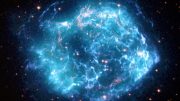

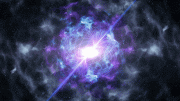
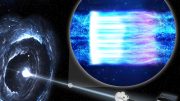
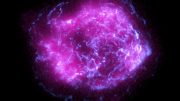
Fascinating. I had never heard of a magnetar. It’s amazing when astrophysics can go from hypothesizing the existence of a weird kind of star, to “Oh there they are” within a few decades. Congratulations to Christopher Thompson and Robert Duncan, who developed the concept of the magnetar in 1992 and not only live to see its confirmation, but to find weird ones like a person could stand on (briefly). Tycho, Kepler, and Einstein had to wait.
A little bit speculation!
Actually they can’t know this richest detailing by indirect measurements! Soon they’ll release a statement that it was a measurement error!
Please explain your concept of how a *direct* measurement of a magnetar would work.
All measuremnts are indirect to a greater or lesser degree.
Hmmm so this is what trapped the OG voltron that year.
The magnetar is the hardest thing I’m the universe. It pulled every atom and every ion near it onto its surface. The gas and plasma are pulled by gravity and magnetism onto the neutron star surface. The surface tension is higher than anyone can imagine
The second sentence is redundant:
“Led by researchers at the University of Padova, the study represents the first time polarized X-ray light from a magnetar has been observed. This was the first time polarized X-ray light from a magnetar had been observed.”
I’ve always been under the impression that neutron stars were solid to begin with? Was I just thinking about it wrong? I mean, these are the same objects that they say are so dense that a teaspoon worth of material would weigh several tons, yes? At that weight and density, wouldn’t it just be essential considered a solid and any other interpretation really just be splitting hairs?
they will usually attract normal matter to settle on their surface which will include solid, liquid and gas, but mostly will be heated and form an atmosphere which polarizes light emitted by the neutronium surface. Once sufficient matter accumulates on the surface, it may perform flares or even a nova, as the accumulated normal matter is converted to neutronium. If the neutron star is already large enough, this added mass will tip it into a supernova and become a black hole.
Remember that these objects are insanely hot, so they may sustain a slim but very dense atmosphere. Modern theory favors the idea of complex onion-like neutron stars. A simplified vision of this model starts with an electrons’ atmosphere, followed by an ocean of ions and neutrons fluid, then a crust of solid neutronium just to be followed by a mantle of superfluid quark-degenerate matter and perhaps a core of solid quark matter.
“Unexpected Results”…90+% of cosmilogical experimental results end up saying “Unexpected Results”. Why? Because Gravitational Theory and all that stems from it IS WRONG! When you have to make up Dark Fairy Dust…I mean Dark Matter (what is it 92% of all the matter in the universe now?) to make your theory work, shouldn’t that tell you something? Talk about unscientific! Everyone due yourself a favor and go to thunderboltsproject.com and enlighten yourself about the Electric Universe Theory…you will be astounded! Do you notice how much this article takes about magnetic fields? Did none of the scientist study Maxwell Theories? It’s called ELECTRO-magnatism! You can’t have one without the other! These people are clueless and they are wasting 100’s of billions of OUR MONEY, on researching a inadequate and false model!
Makes you wonder what else they are wasting money on & more importantly why ?
The Lies of these guys will never end. Those who believe this are good as Dump as you…!
Spare the Tax payers money by doing your False research, you will never understand or know GOD’s secrets unless they are Revealed to you.